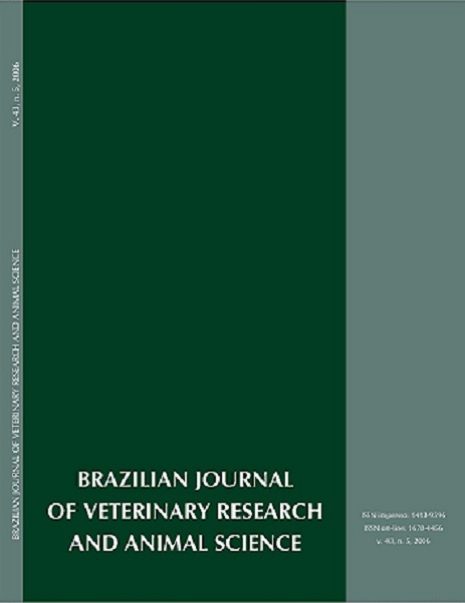Presença de anticorpos anti-Neospora caninum e Toxoplasma gondii em cães com leishmaniose visceral da região de Araçatuba, São Paulo, Brasil
DOI:
https://doi.org/10.11606/issn.1678-4456.bjvras.2006.26569Palavras-chave:
Leishmania chagasi, Toxoplasma gondii, Neospora caninum, Cães, Epidemiologia, BrasilResumo
Cães soropositivos e soronegativos à Leishmania chagasi da região de Araçatuba, São Paulo, Brasil, foram avaliados quanto à presença de possível co-infecção por Neospora caninum e Toxoplasma gondii. Amostras de sangue de 204 cães, sendo 98 portadores de leishmaniose, foram coletadas e os soros testados quanto à presença de anticorpos anti-L. chagasi pelo método de ELISA e anti-T. gondii e N. caninum pela reação de imunofluorescência indireta (RIFI). Idade, sexo e possíveis associações entre a presença de anticorpos anti-L. chagasi e a soroprevalência de N. caninum e T. gondii foram analisados pelo teste do Qui-quadrado. Dos 204 soros examinados, 36 (17,6%) foram positivos para N. caninum (RIFI ³50) e 75 (36,8%) para T. gondii (RIFI ³16) com títulos que variaram de 50 a 6.400 para N. caninum, e de 16 a 16.384 para T. gondii. A co-presença de anticorpos anti-L. chagasi, N. caninum e T. gondii foi observada em 17 (8,3%) cães. Anticorpos anti-N. caninum foram observados em quatro (3,8%) dos 106 cães negativos e em 32 (32,6%) dos 98 cães positivos à L. chagasi. Anticorpos anti-T. gondii foram encontrados em 40 (41%) e em 35 (33%) dos 98 cães positivos e dos 106 cães negativos à L. chagasi, respectivamente. Foi observada associação entre a presença de anticorpos anti-L.chagasi e a presença de anticorpos anti-N. caninum (p;0,05), com exceção da idade e presença de anticorpos anti-L. chagasi , que apresentou uma associação fraca (p=0,038), com maior número de cães com mais de quatro anos de idade positivos a esse agente quando comparado às outras idades.Downloads
Downloads
Publicado
Edição
Seção
Licença
O conteúdo do periódico está licenciado sob uma Licença Creative Commons BY-NC-SA (resumo da licença: https://creativecommons.org/licenses/by-nc-sa/4.0 | texto completo da licença: https://creativecommons.org/licenses/by-nc-sa/4.0/legalcode). Esta licença permite que outros remixem, adaptem e criem a partir do seu trabalho para fins não comerciais, desde que atribuam ao autor o devido crédito e que licenciem as novas criações sob termos idênticos.





